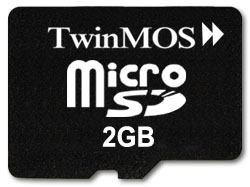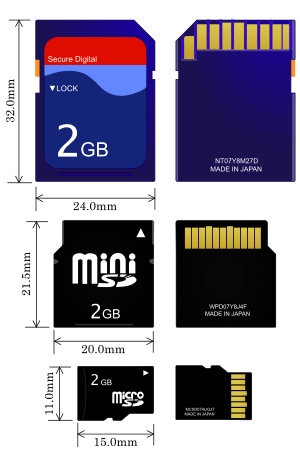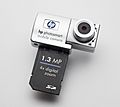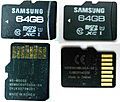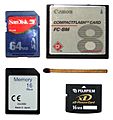MicroSD facts for kids
A microSD card is a super tiny flash memory card. It's used to store lots of information, like photos, videos, and apps. The "SD" in microSD stands for "Secure Digital." These cards are often called µSD or uSD too. You'll find them in many mobile phones and other small electronic devices.
MicroSD cards are the smallest memory cards you can buy. They are only about 15 millimeters by 11 millimeters by 1 millimeter. That's roughly the size of your fingernail! This makes them about a quarter the size of a regular SD card. Even though they are so small, you can use adapters to make them fit into devices that use bigger cards. For example, an adapter can make a microSD card fit into a standard SD card slot, a miniSD slot, or even a USB port. Many microSD cards are sold with a standard SD adapter already included.
There are different types of microSD cards. The first ones were called TransFlash, but they are the same as microSD cards. Newer versions include microSDHC and microSDXC. These newer cards can store much more data. Older devices might not be able to use the newest cards, but sometimes special software can help them work.
MicroSD cards come in many sizes. Early TransFlash cards were 16MB or 32MB. Today, microSD cards can hold from 64 MB up to 32 GB. MicroSDHC cards range from 4 GB to 64 GB. The biggest ones, microSDXC cards, can store from 8 GB all the way up to 1 TB (that's 1000 GB!).
Contents
How MicroSD Cards Were Created
The tiny microSD format was first made by a company called SanDisk. It was first known as T-Flash, then TransFlash. Later, it was officially named microSD when the SD Card Association (SDA) started using it. The SDA is a group that approves different types of flash memory cards, like miniSD and standard SD cards.
The SDA first announced the microSD format at a big event called CTIA Wireless on March 14, 2005. The full details about the microSD cards were shared a few months later, on July 13, 2005. When they first came out, microSD cards were sold in sizes like 32 MB, 64 MB, and 128 MB.
In July 2006, SanDisk made a 4 GB microSD card. It cost about $99 USD back then. But over time, the prices for these memory cards dropped a lot. By April 2009, a 4 GB card could cost as little as $12 USD. By May 2009, you could find them online for just $6 USD! In January 2010, a 16 GB microSD card cost about $40 USD, and a 4 GB card was around $8 USD.
In February 2014, SanDisk announced an even newer microSD card called the MicroSDXC. These cards could hold a massive 128 GB of data! To make this possible, SanDisk found a way to stack 16 memory chips on top of each other. Each chip was made thinner than a strand of hair! When these cards were released, their sizes ranged from 8 GB to 128 GB, and their prices were between $29.99 and $199.99.
How Much Power MicroSD Cards Use
Different companies make microSD cards, and they use different amounts of electricity. Most microSD cards use between 0 and 100 milliamperes (mA) of power when they are working. This is at a supply voltage of 3.3 volts. For example, one company, TwinMOS Technologies Midde East FZE, says their cards use a maximum of 45 mA when transferring data. Another company, Toshiba, says their cards use between 80 and 100 mA.
Related pages
Images for kids
-
SD cards with dual interfaces: SD and USB.
-
A shield (daughterboard) that gives Arduino prototyping microprocessors access to SD cards.
-
Official pin numbers for each card type (top to bottom): MMC, SD, miniSD, microSD. This shows how SD evolved from the older MMC. NOTE: This drawing doesn't show 8 new UHS-II contacts that were added in spec 4.0.
-
Inside a 512 MB SD card: NAND flash chip that holds the data (bottom) and SD controller (top).
-
Size comparison of various flash cards: SD, CompactFlash, MMC, xD.
See also
 In Spanish: MicroSD para niños
In Spanish: MicroSD para niños


